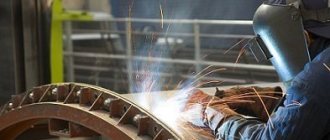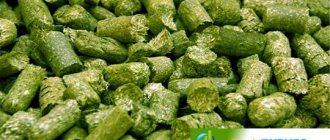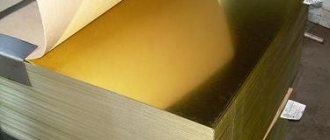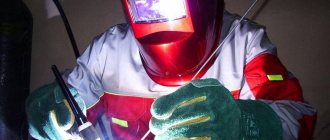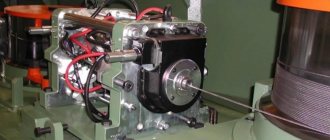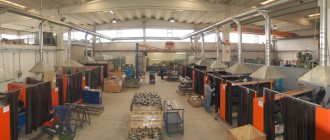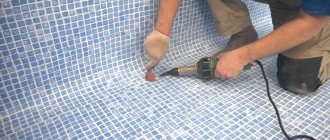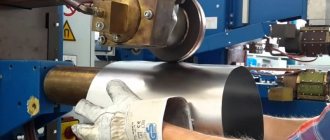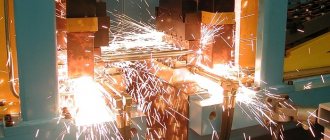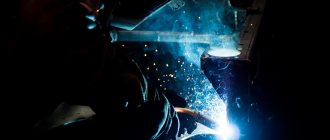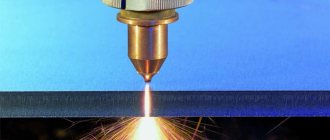Home / Useful
Back
Reading time: 8 min
0
821
- What is welding production?
- Types of welding production.
- Welding technology and types of welding Manual electric arc welding using non-consumable electrodes
- Manual arc welding with consumable electrodes
- Electric arc welding in a protected environment
- Automatic and semi-automatic welding
Thermal connection of parts
You can learn everything about metal welding in special courses for welders. However, beginning craftsmen should first decide on the very concept of welding, the theory and the main things about it. It is necessary to begin studying these basics by understanding, first of all, what is called welding and how welding occurs.
Metal parts can be connected to each other mechanically without using heat. In contrast to mechanical joining, with the thermal method the parts are heated to their melting point. Therefore, the definition of “what is welding” implies precisely this method of forming connections that are durable and reliable. Welding is the process of obtaining a permanent connection of elements by heating them strongly.
There are many different types of welding, equipment used in this process, technologies used and control methods. Welding theory suggests that welding is a high-temperature process. This is achieved through the formation of a welding arc, which promotes the melting of the metal elements being connected.
Device design
Structurally, the device for rectifying voltage and creating a powerful welding current looks like this:
- the need to reduce the input voltage means the presence of a transformer, it converts alternating 50 Hz current 220/380 V into low voltage voltage;
- a powerful diode bridge rectifies alternating voltage into cyclic direct voltage;
- a high-capacity smoothing capacitor filter converts pulsating voltage into an almost linear direct voltage;
- current control unit;
- chokes that limit the increase in welding current.
The design of the devices may differ slightly from the simplified diagram to improve technical characteristics, but using this principle you can assemble a welding rectifier with your own hands. It will allow you to perform simple welding work at home and in the country.
When argon welding, a welding machine is used. The welding technique makes it possible to obtain a high-quality, even seam on long sheet metal surfaces. The electrodes used in seam welding resemble rotating rollers. The metal sheets to be welded are passed between them.
To generate heat during argon welding, oxidation of combustible gas having a high calorific value (propane, butane, acetylene) is used. Inside the burner, oxygen is mixed with gas.
Main types of welding
There are various welding methods available. Welding methods and types of welded joints must be known in order to select the right equipment, consumables and set the necessary modes. Types of welding and their brief characteristics should be the knowledge that will result in obtaining a high-quality, beautiful and durable seam. Each method has its own nuances, advantages and disadvantages.
Welding can use heat or pressure, or a combination of both. In accordance with this, types of welding and their characteristics are divided into two large groups - melting and pressure.
Welding technology consists of forming an interatomic bond between metal products and resulting in a strong permanent connection. The first stage of the process is to bring the welded elements as close as possible to each other.
However, at this stage, sufficient mutual penetration of atoms is impossible. This is explained by the fact that at normal temperatures even significant efforts will not help. This will be prevented by the hardness of the material, and also by the fact that even with the best processing, contact between parts will not occur over the entire surface, but only at several points. In addition, a strong connection will be hampered by residues of dirt, oxides, and fatty films on the surfaces.
Strong physical contact will only be possible as a result of applying strong pressure or melting the edges of the metal parts being connected. At the same time, the gap between the parts being connected disappears, and they begin to form a single whole.
Types of classification of welding methods include fusion welding without the use of pressure, thermomechanical welding using thermal energy and pressure, and pressure welding. A common method is to melt the elements being connected.
Metal welding methods:
- Manual electric arc.
- Gas.
- Semi-automatic.
- Automatic.
- TIG welding.
- Electron beam.
- Electroslag.
- Plasma.
- Diffusion.
- Contact electric.
- Butt contact.
- Suture contact.
- Point contact.
- Spot condensate.
- Induction.
The electrodes used in this case are either consumable or non-consumable. A brief description of the main types of welding will help you choose the most suitable method for a particular process. All types of welding work require the use of equipment suitable for them.
Welding different metals also has its own characteristics. For example, the difficulty in welding carbon steels lies in the hardening of the zone near the seam, and the formation of numerous cracks. Therefore, when welding products from such materials, it is recommended to preheat the parts to a temperature of 100-300 degrees, use a multi-layer weld, use coated electrodes, and after completing the process, temper the resulting product to a temperature of 300 degrees.
The difficulty in welding ferritic steels with a high chromium content is that during cooling there is a risk of chromium carbide grains falling out, which reduces the resistance to corrosion. To prevent this phenomenon, the current should be set to a low value so that a higher cooling rate can be achieved. Also, to equalize the amount of chromium in the grains and at the boundaries, annealing can be carried out after welding.
Welding of cast iron products is carried out using cast iron electrodes with preheating of the parts. The diameter of cast iron electrodes is chosen in the range of 8-25 millimeters.
The weldability of copper is reduced by impurities of oxygen, hydrogen and lead. The use of gas welding is effective. If arc welding is used, then carbon or metal electrodes are chosen. Welding of aluminum parts is hampered by the presence of oxides. The use of fluxes helps dissolve them.
Stages of certification in NAKS
Certification of welding technology presupposes the fulfillment of mandatory conditions for permission to undergo certification at the National Agency for Welding Control - NAKS.
Prerequisites
- The presence of at least 2 welders in the organization’s staff, certified by NAKS, having a special certificate, as well as welder vacancies.
- Availability of a welding production specialist (welding process engineer) of the third degree of NAKS.
- Availability of a non-destructive testing laboratory certified in a certain order (agreement with an independent laboratory providing its own services).
- Availability of approved technical documentation for welding technologies.
- Availability of certificates for all types of metals, NAKS certificate of certification.
Next, the welding production technology is examined for its characteristics, on the basis of which an application will be drawn up for certification of the technology at NAKS.
Procedure for passing certification at NAKS
- Based on the documentation provided, the organization creates a certification program at the National Control Agency, which is fully carried out by specialists from the certification agency. The company submitting the application is only required to sign documents and affix stamps in a timely manner.
- After completing the necessary documents, representatives of the certification center, together with representatives of the certified enterprise, perform test welding work. The laboratory is certified in accordance with the established procedure.
- Based on the test results, conclusions are drawn and laboratory reports are issued. They are filed with the general package of documents collected at NAKS.
- Next, the package of documentation is transferred to the certification center, and a certificate is obtained indicating the readiness of the production that submitted the application to use the certified technology.
Arc welding
Types of fusion welding can start with MMA, as manual arc welding is called. She can deservedly be considered a leader of popular popularity. This metal welding process can be carried out using an inverter or transformer. In both cases, the use of electrodes is necessary. This method is simple and inexpensive.
The source of heat is an electric arc formed between the electrodes, one of which is a consumable material, and the other is the elements being welded. Such an arc is a powerful discharge in a gaseous environment.
The electrode coating can be compared to a “frozen” gas cloud. When the metal begins to melt, the electrode coating also begins to melt. The released cloud of gas provides protection against the penetration of oxygen into the weld formation site, and provides a conductive ionized environment for the arc. This phenomenon significantly reduces the risk of porosity formation.
Advantages of MMA:
- Versatility. Using this technology, you can weld products made from almost all types of metal.
- Parts can be welded using this method in any spatial position of the product. This includes confined spaces that may not be possible with other methods.
- The technology of metal welding using the MMA method allows this to be done under various unfavorable environmental conditions.
- Ease of use and low cost make it possible to use this method not only in industrial settings, but also at home.
The disadvantages include low productivity, the presence of at least a little experience, a rather complex process of igniting the arc with the risk of electrode sticking, and harm to health when the coating of some types of electrodes evaporates.
The use of modern equipment that has functions against the occurrence of such an effect will help to avoid electrode sticking. Equipment for arc welding is divided into transformers and inverters, which have undeniable advantages and greatly facilitate the process of electric welding.
Transformers, which have held the lead for a long time, are now considered obsolete equipment, heavy and large in size. They can only be used to weld metal parts using alternating current.
The way out is to use welding rectifiers. Their function is to convert alternating current into direct current. This provides a significant advantage, since when using direct current, the seams are of higher quality, smoother, stronger and neater. However, rectifiers are also heavy and large in size, and their use requires professional skills.
Inverters, which are modern equipment, are the best choice for implementing the process. This can be recommended even for beginners, since it is not difficult to understand the principles of working with them. The current rectifier is built into the inverter device, so no additional equipment is required. The available functions will help avoid sticking of the electrodes and help quickly ignite the arc. Inverters are so light in weight and small in size that they can be easily carried in your hands.
Electrodes should be selected according to parameters such as their diameter and the composition of the metal inside. The choice of the type of metal is important, since during the welding process it melts, and it flows drop by drop into the total mass and fuses with it. The homogeneity of the metals of the parts and the electrode guarantees a strong connection and a uniform seam.
It is not difficult to make the right choice when purchasing electrodes, since the packaging usually indicates what types of metals these consumables are suitable for. When purchasing, you also need to decide on the thickness of these consumables. This directly depends on the thickness of the products being welded.
It is important to acquire skills when igniting an arc. You can choose to use touch or swipe methods. When touched, the electrode quickly comes into contact with the surface of the product and then moves away a short distance. You should continue tapping the electrode on the surface until an arc appears. Striking the electrode over the surface like lighting a match is more preferable, but is inconvenient in hard-to-reach places. The skills to quickly ignite an arc come with experience.
After ignition of the arc, it is important to maintain its combustion stability. To do this, the electrode must be kept from the surface at a constant distance of approximately two millimeters. As the electrode burns, do not forget to lower it. If you hold the electrode too close to the surface of the product, it may stick to it, and if it is too far away, there is a danger that the ignited arc will go out.
The basics of electrode welding suggest that it is better to heat the metal in a circular motion so that the so-called weld pool has time to form. To ensure an even seam, after heating, the electrode should not be moved too slowly, but not particularly quickly, in order to avoid the appearance of defects.
Where to begin
The design of welding shops is of paramount importance.
What is it? There are several positions here that will determine the technological process regarding welding work, as well as the assembly of components and parts. First of all, you need to sort out the equipment. It is clear that the main equipment for a welding shop is welding machines (gas, electric). Their cost is determined by the volume of work performed.
If the volumes are large, then it is better to purchase professional devices. If the welding shop is small, then you can get by with household analogues. A welding shop needs to be diverse to accommodate as much work as possible, so it's worth considering purchasing a resistance welder.
We must not forget about seemingly simple devices that will occupy a certain place in the welding shop. For example, a workbench or a welding table.
It must be properly organized not only in terms of the convenience of welding operations, but also in terms of quick access to additional tools and consumables. Moreover, a welder’s workplace is a single set of devices that are used daily.
Gas welding
Welding methods include such a common method of joining products as gas melting. The essence of gas welding is that the edges of the parts at the points of their connection are heated to the required temperature using a torch included in the equipment used.
Knowing everything about welding involves studying this time-tested method of joining metals. Gas welding is not difficult to perform, the equipment for it is not particularly expensive, little electrical energy is consumed, which is an undeniable advantage.
A relative disadvantage is the low rate of heating of the metal, which decreases even more if thick parts have to be welded. Therefore, it is recommended to use it when welding metal sheets no more than six millimeters thick. An unpleasant defect such as warping may also appear. Almost all types of metals can be welded using the gas method.
Unlike arc welding, electrodes are not used here. Their role is played by the filler wire, and the heat source is the burner. Transitioning into a liquid state, the metal forms a weld pool, which will subsequently be protected by a gaseous environment that displaces air. The molten metal slowly cools and solidifies.
A high-temperature flame is formed by the combustion of a mixture of acetylene and oxygen. This mixture acts as an oxidizing agent. Instead of acetylene, you can use its substitutes, for example, methane or propane-butane, but it should be borne in mind that this will lower the combustion temperature, so this replacement is mainly carried out when cutting metals or when welding metals that have a low melting point, such as copper, brass, bronze. Acetylene has the highest combustion temperature.
The welding process in this way is divided into “right” and “left” techniques.
The most common is the “left” method. It can be used when joining metals that have a not too high melting point and a small thickness. The “right” method is used to connect metal products with a thickness of over three millimeters that have increased thermal conductivity. Thanks to better protection of the metal, the weld is of higher quality, the process speed is increased, and gas consumption is 10% less.
With the “right” method, the direction of movement of the torch is from left to right, and the filler wire is moved after the torch. In this case, the flame is directed to the already finished section of the seam, and the filler wire is moved after the burner. With the “right” method for thick parts, preliminary cutting of the edges of the parts is necessary.
The mouthpiece vibrates with a small amplitude, except when welding thin-walled sheets. The burner flame is directed so that the edges of the parts are located in the reduction zone and are at a distance of 2-6 millimeters from the end of the flame. The burner mouthpiece can be perpendicular to the surface or inclined towards it.
The technical process for gas welding suggests that before starting work, it is necessary to check the operating condition of the torch:
- Quality of hose connections.
- Presence of vacuum.
- Gas tightness.
Before connecting oxygen and acetylene hoses to the burner, they must be purged. To check that the hoses are securely connected, do the following:
- connect the oxygen supply hose to the burner fitting;
- check the burner for vacuum in the channel where acetylene is supplied;
- connect the acetylene supply hose;
- check that the hoses are securely fastened with clamps designed for this purpose.
Instead of clamps, you can secure the hoses with wire. Union nuts with right-hand or left-hand threads are also used.
Checking for vacuum or otherwise “suction” should be carried out as follows:
- secure the tip with a union nut;
- attach the oxygen supply hose to the nipple;
- monitoring the pressure gauge readings, set the oxygen pressure;
- open the valves - first acetylene, and then oxygen;
- Place your finger near the acetylene nipple.
If your finger sticks, this will mean that there is a vacuum. In its absence, you should:
- close the oxygen valve and disconnect the tip;
- Unscrew the injector from the mixing chamber half a turn;
- assemble the burner and recheck;
- if there is still no vacuum, you will have to remove the tip, take out the injector and mouthpiece, and check whether the holes in them are clogged;
- if necessary, clean the holes with soft wire and blow with air;
- Check the tight fit of the injector to the seat of the burner body and, if necessary, tighten it.
Then a gas tightness test is carried out:
- connect the oxygen supply hose alternately to the acetylene and oxygen nipples;
- supply oxygen under pressure;
- Place the mouthpiece in the water for a few moments.
In the absence of gas impermeability, bubbles should not appear on the surface of the water. Gas welding performs well when welding using the butt method. However, it is not recommended to use it to form joints using the overlap and tee methods, since this requires strong heating of the parts.
The welding process should be carried out by moving the torch in only one direction - along the axis of the seam. The lack of vibration results in a narrower weld than when welding with coated electrodes is performed. To avoid splashing, the end of the wire must be fed smoothly into the bath. The degree of penetration can be judged by the appearance of the bath. With normal penetration, it will be elongated along the direction of the seam, and with poor penetration, the shape of the bath will be round or oval.
The end of welding and welding of the crater is carried out by gradually reducing the current strength using a rheostat included in the welding circuit. It is not recommended to stop welding by lengthening the arc, retracting the torch, since this method will worsen the gas protection of the seam. The gas supply should only be stopped a few seconds after the arc stops burning.
Location of equipment and fixtures
The equipment layout is strictly regulated by safety standards and regulations in welding shops. The layout determines safety, ease of movement of personnel, movement of parts, assemblies and finished products. There are several recommendations for arrangement:
- if a transformer is used in the workshop for electric welding, then it should be installed 5-7 m from the workbench and half a meter from the wall (minimum). The household inverter can be installed on a table surface;
- if welding is performed with gas, then cylinders with oxygen and acetylene are placed away from each other at a distance of at least 5 m. The same applies to propane equipment. The same distance is maintained between the welding site and the cylinders;
- gas hoses and electrical cables are laid away from passages so that they are not walked on. This is primarily a safety requirement, and secondly a way to preserve property;
- a distance of 1 m is left between equipment, tables, cabinets and other bulky objects for the convenience of moving people and transporting parts on carts.
Automatic welding equipment requires more space. It is necessary to take into account its movement around the welding shop and the access of performers to it.
Semi-automatic welding
All types of welding work include another popular type - welding using a semi-automatic machine. Semi-automatic welding can be called a type of arc welding. The difference lies in the fact that at the same time, wire is supplied to the welding zone and gas is exposed, which protects all materials from the negative effects of ambient air, which can slow down the process or even stop it completely.
When semi-automatic welding occurs in carbon dioxide, this type is called MAG, and if in inert, then MIG. Semi-automatic welding machines are a simple type of equipment. Its main parts consist of a direct current source that supplies voltage, and a special mechanism for feeding wire into the welding zone, which acts as an electrode. The wire is wound on a special bobbin. Its feed speed is adjustable.
The advantages of this method include the ability to work in hard-to-reach places, a small amount of waste, obtaining a thin and durable seam, and the speed of the process. Semiautomatic machines use aluminum or steel wires. Protection of the resulting seam is possible in the following ways: flux; protective gases; using flux cored wire. Shielding gases are most often used. There are stationary devices and household ones, more convenient for home use.
The semi-automatic body contains a control unit and a power source. Using cables, the device is connected to a wire feeding mechanism wound on a reel and a welding torch.
Wire feeding is carried out in one of three ways:
- Pulling. The drive is located on the burner handle. The wire is pulled out from the bobbin on which it is wound.
- Pushing. The drive pushes the wire towards the torch.
- The push-pull feed is a hybrid of the two previous methods.
Using a welding sleeve, gas, wire and, in some models, cooling liquid are supplied to the work site. The length of the hose determines the ability to work in hard-to-reach places. A unified connector is used to connect the welding hose.
In the center there is a large fitting through which the welding wire exits. At the top there are two contacts for switching modes. Wires are connected to the connector to supply current. A burner is also connected to the hose. The contact tip is a replaceable part. It is selected depending on the diameters of the wire used. In turn, the size of the nozzle depends on the diameter of the tip.
The wire is wound onto spools. They have different sizes depending on the diameter of the wire. The wire feeder has a roller mechanism. The feeder rotates using an electric motor. The wire tension is adjusted manually by the operator. The welding wire enters the welding zone continuously. The arc occurs between the wire and the parts to be welded. The nozzle serves to form a gas cloud.
Semi-automatic welding without the use of gas is possible. In this case, it is necessary to use a special type of wire containing flux inside. This type of wire is called flux-cored wire. When the wire burns, the freed flux creates a protective environment. If you have to weld critical structures, you should choose gas welding, which is more reliable. A competent choice of welding wire is necessary.
The main criterion is the correspondence of the wire composition to the material of the products being welded. Marking the wires will help with this. The choice of wire diameter depends on the thickness of the products. The theory of metal welding assumes that the set welding current depends on the thickness of the materials and the selected diameter of the electrodes.
It is necessary to establish the speed at which the wire will be fed, as well as the gas flow, set using a valve on the gearbox. The main feature of using a semi-automatic machine is that initially the wire is fed towards the welding site mechanically, but then it is moved manually.
Type, power, power
Let's look at three more main aspects that need to be considered when choosing welding equipment. The first aspect is the type of equipment. It can be domestic, professional or industrial. Household models can operate continuously for no more than thirty minutes, after which they require a break of one hour. Professional units can easily blow for eight hours, without interruption. As for industrial devices, they only require a short technical break. And so they can work for several shifts in a row.
If we talk about nutrition, there are also several options here. For example, single-phase units are designed for 220 Volts, which means that they can be connected to a regular electrical outlet. This type of power supply is typical for low-power devices, which are very popular due to their ease of use. However, it should be remembered that they still create an additional load on the network, as they consume a lot of power.
Three-phase devices are designed for 380 Volt sockets, which are more often found in specialized workshops and production shops. Such sockets are capable of providing more power, but they are not found in domestic conditions.
There are also models of welding machines that can operate in two modes at once. Although they are more expensive, they are more practical, although in cases where a three-phase outlet is not planned to be used, there is no point in overpaying.
If we talk about power, then it determines what thickness of the workpiece the device can work with. It follows from this that the greater the power, the thicker the part can be processed. Determining the parameter is extremely simple. You just need to find in the reference book the required amperage for a certain thickness of metal. After this, the current is multiplied by the voltage. The result obtained must be divided by the efficiency of the welding unit: for transformers it is 0.6, and for inverters it is 0.8. The resulting value is the power of the welding equipment.
Automatic welding
This type of welding, which has many advantages, is often used in industrial production. It can be called the highest degree of mechanization of electric arc welding, performed under flux protection.
Wire feeding is completely mechanized. The welder only needs to know how to set up the equipment used and start it up. The resulting seam is smooth and beautiful due to the fact that an even burning of the arc is maintained throughout the entire process.
Ventilation system
Ventilation of the welding shop is the most important component and one of the main requirements for organizing welding shops. With its help, heavy gases from the melting of metals and combustion of electrode rod coatings are removed from the welder’s workplace.
Many people make the mistake of installing a probe above a large workbench, which is connected to the general ventilation system by pipes or corrugations. The optimal and effective option is to install a side gas outlet so that they do not rise above the level of the workpieces being welded.
It is very important to make an accurate calculation of the ventilation system to ensure maximum air extraction from each workplace. It is better to install the fan outside the workshop. This will be especially true if the welding shop is organized in a garage.
A small room without ventilation will become a place where it will be impossible to stay without a respirator or gas mask. And the SES will not give permission to operate such a poorly equipped workshop. Therefore, it is very important not only to install a ventilation system, but also to correctly calculate the characteristics of the fan, especially the power of the device .
Plus, distribute the air ducts correctly so that they do not interfere when moving large parts. This means that you will have to make a drawing with the condition of the correct arrangement of all elements of the system.
TIG welding
It is one of the modern methods of welding various products. The essence of this method is the combustion of an electric arc in argon, a gas that has a number of remarkable qualities. Since it is heavier than air, after penetrating the weld pool, argon begins to protect it from other gases living in the atmosphere. The result is a seam without an oxide film.
This method uses a tungsten electrode, which makes it possible to weld various types of steel. It requires constant care, which includes regular sharpening of its tip. For ignition, an oscillator is required that generates a high-frequency current, which is connected to the inverter.
The operating principle of automatic argon arc welding is similar to the manual version, with the difference that control occurs automatically according to the program set by the operator. This type of welding uses an inverter. When welding with an inverter, the theory of the process is that such a device allows you to convert direct current into alternating current. The inverter can then change the frequency of the resulting alternating current.
Prohibited actions
According to safety regulations, when performing welding work you must not:
- Continue the process if the welding helmet is damaged.
- Work with a faulty or disconnected ventilation system. You cannot continue welding outside after it starts to rain or snow. This increases the risk of electrical injury.
- Connect loose metal workpieces using electric welding. Do not hold parts with your hands.
- Cook in areas with flammable materials or gases.
- Connect new elements to pipelines under pressure.
- Use thick metal sheets or profiles as grounding.
- Keep the holder or electrode closed for a long time. This contributes to the failure of welding equipment.
We recommend reading: How to make sliding gates yourself
Safety precautions - rules for safe welding work.
Electroslag welding
It is characterized by very high productivity and efficiency. Electroslag welding is applicable in production of any size. The essence of ESW is that the elements are joined in a molten slag environment. An electrode is lowered into it, through which an electric current passes. Thus, heat begins to be generated in the slag.
Equipment for ESW consists of a welding machine and additional devices for performing auxiliary functions.
Universities
- Russian State University of Oil and Gas named after Gubkin.
- Moscow Automobile and Road Transport State Technical University.
- National Research University MPEI.
- Moscow State Technical University STANKIN.
- Moscow Polytechnic University.
- MEPhI.
- Moscow Technical University named after Bauman.
- Baltic State Technical University Voenmekh.
- St. Petersburg Polytechnic University named after Peter the Great.
- Samara National Research University named after Academician Korolev.
- Vologda State University.
Electron beam welding
Metal welding techniques include rapidly evolving technologies. These include electron beam welding. Its essence lies in the fact that the heating of products and their further melting occurs under the influence of a flow of high-speed electrons that move in a vacuum under the influence of an electric field.
Under the influence of a focused flow of electrons, the edges of the parts melt and join together. The range of its capabilities is very extensive - refractory and chemically active metals, durable alloys.
The features of this type of welding include the fact that since welding occurs in a vacuum, the surfaces of the parts remain clean, and also the fact that the seam is produced quickly and has minimal thickness. It maintains increased quality even if parts of different thicknesses, having different compositions and melting temperatures are welded. The welding equipment is easy to operate and does not require extensive training.
What is the danger?
The physical and chemical hazards of welding include:
- high noise level emitted by welding machines;
- intense infrared and ultraviolet radiation;
- blinding visible light;
- content of heavy metals in melt vapor;
- presence of hot particles above the weld pool;
- thermal energy generated during burner operation.
When carrying out welding work, a person is exposed to ultraviolet radiation.
Diffusion welding
Modern welding methods also include a type called diffusion welding. Its essence lies in the fact that mutual penetration of the atoms of the parts being connected occurs when they are strongly compressed and heated to a certain temperature.
The heating temperature depends on the properties of the metal, but is not too high.
Admission conditions
Future engineers are trained through bachelor's programs. Admission is possible only if you have completed secondary education (11 grades).
Applicants take entrance exams:
- physics (major subject);
- mathematics;
- Russian language;
- foreign language (at the discretion of the university).
Forms of training – full-time and part-time. The duration of full-time study is 4 years, part-time study is 5 years.
contact welding
In resistance welding, a permanent connection is formed by heating the parts by passing through them with an electric current and applying pressure. The area of use is industrial production, mass and serial.
The following types of resistance welding are available:
- point;
- butt;
- suture;
- embossed;
- suture-butt.
Spot welding is the most widely used. The welding process in this way consists of connecting parts in one or several places depending on their length.
The metal does not heat up to its melting temperature along its entire length, but only at certain points. The seam is reliable and aesthetically pleasing. The use of this method reduces the time of the welding process. The number of controlled parameters is small, so there are no special requirements for the welder’s qualifications.
Automation of production
To increase labor productivity, automation of welding production is used. The costs of its implementation will pay off the faster, the more multi-batch the production is.
The main advantage of automating the welding process is the improved quality of the results obtained. This occurs due to the fact that during automation, the algorithms of computer systems take over the leadership. Accordingly, defects decrease and quality increases. The seams are identical, close to existing standards. It becomes possible to weld structures that have increased responsibility.
In addition, the advantages include a reduction in material costs and a reduction in the number of performers. They may have lower qualifications and, accordingly, savings occur on paying them wages. Mechanization and automation of welding production make it possible to optimize all stages of the welding process.
Welding process
The basics of welding include the concept of preliminary drawing up a process plan. This will be a kind of guide to the competent implementation of the welding process. The technological process of welding specific products will help take into account all their features and nuances.
The description of the welding technological process is set out in a special document called a technological map. It can be considered a kind of normative document that sets out the theory of welding work. The technological process at the welding site, outlined in the map, is an indispensable assistant to the welder.
Example of a welding process:
Guiding material in the form of a technological map should contain information about the brands of parts being welded and recommendations on the choice of method of their connection and spatial arrangement. The welding technological process covers the requirements for the parameters set on the equipment used, the diameter of the electrodes used, recommendations for protecting the environment, and setting the polarity.
The technological process of welding a product contains information about the sequence of actions performed. It may also contain calculations of the applied materials required to carry out the process. The technological map contains small sketches, which increases clarity.
Requirements for employees and managers
It is permissible to manage welding processes at hazardous production facilities only to those workers who correspond (and this is confirmed by documents) to highly specialized professional knowledge. A mandatory point is the presence of a NAKS certificate.
In addition, it is important for managers to be able to read welding drawings and know basic technical abbreviations and designations. You can learn more about how welds are designated in the drawings - welding symbols - in the article on our website.
Workers directly involved in the management of the welding process are faced with the following tasks:
- prepare performers for this dangerous process;
- select suitable employees;
- clearly control the stages of welding processes;
- guarantee the quality of the final welds.
Important: in emergency situations, a leader must be calm-blooded and be able to make instant, correct decisions.
Only those performers who have completed specialized training and qualifications in their specialty plus received a welder’s certificate indicating the category assigned after passing theory and practice are allowed.
When welding at hazardous production facilities, a confirmed highest qualification in the specialty is required. In organizations, welders who have completed the training process and certification are assigned a personal stamp by order; its number is indicated in the certificate.
It is important that a performer admitted to the welding process should not have any contraindications for both regular preventive medical examinations and those carried out immediately before each work shift.
Search for clients
In order for welding as a business to generate high income, you need to choose the right direction of activity. Among private clients, services for the production of barbecues, frames for greenhouses, fencing, fences, gratings and various decorative products are in demand. A popular area is car body repair. It is also beneficial to cooperate with large construction companies. Experienced welders are needed at any stage of building construction.
To promote the services of a welding shop, you can use advertising on social networks and on large advertising sites. It is recommended to print flyers and/or business cards with contact information and a list of services and place them in the mailboxes of people living in the private sector. It must be said that such a business does not need active advertising. If the first few people who use the workshop’s services are satisfied, then an influx of new clients is guaranteed. The so-called word of mouth is the main engine of this business.
